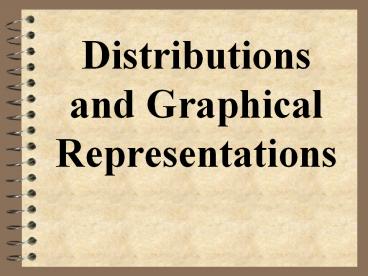Distributions and Graphical Representations PowerPoint PPT Presentation
1 / 26
Title: Distributions and Graphical Representations
1
Distributions and Graphical Representations
2
Statistics
- the science of collecting, analyzing, and drawing
conclusions from data
3
Descriptive statistics
- the methods of organizing summarizing data
4
Inferential statistics
- involves making generalizations from a sample to
a population
5
Population
- The entire collection of individuals or objects
about which information is desired
6
Sample
- A subset of the population, selected for study in
some prescribed manner
7
Variable
- any characteristic whose value may change from
one individual to another
8
Data
- observations on single variable or simultaneously
on two or more variables
9
Types of Variables
10
Categorical variables
- or qualitative
- identifies basic differentiating characteristics
of the population
11
Numerical variables
- or quantitative
- observations or measurements take on numerical
values - makes sense to average these values
- two types - discrete continuous
12
Discrete (numerical)
- listable set of values
- usually counts of items
13
Continuous (numerical)
- data can take on any values in the domain of the
variable - usually measurements of something
14
Classification by the number of variables
- Univariate - data that describes a single
characteristic of the population - Bivariate - data that describes two
characteristics of the population - Multivariate - data that describes more than two
characteristics (beyond the scope of this course
15
Identify the following
- gender
- age
- hair color
- smoker
- systolic blood pressure
- number of girls in class
- categorical
- numerical
- categorical
- categorical
- numerical
- numerical
16
Types of Distributions
- 4 common types
17
Symmetrical
- refers to data in which both sides are (more or
less) the same when the graph is folded
vertically down the middle - bell-shaped is a special type
- has a center mound with two sloping tails
18
Uniform
- refers to data in which every class has equal or
approximately equal frequency
19
Skewed (left or right)
- refers to data in which one side (tail) is longer
than the other side - the direction of skewness is on the side of the
longer tail
20
Bimodal (multi-modal)
- refers to data in which two (or more) classes
have the largest frequency are separated by at
least one other class
21
How to describe a graph
- Dotplots
- Stem leaf plots
- Histograms
- Boxplots
22
1. Shape - Type of distribution
- refers to the overall shape of the distribution
- symmetrical, uniform, skewed, or bimodal
23
2. Center
- discuss where the middle of the data falls
- three types of central tendency
- mean, median, mode
24
3. Spread
- discuss how spread out the data is
- refers to the variability of the data
- Range, standard deviation, IQR
25
4. Unusual occurrences
- outliers - value that lies away from the rest of
the data - gaps
- clusters
- anything else unusual
26
5. In context
- You must write your answer in reference to the
specifics in the problem, using correct
statistical vocabulary and using complete
sentences!

